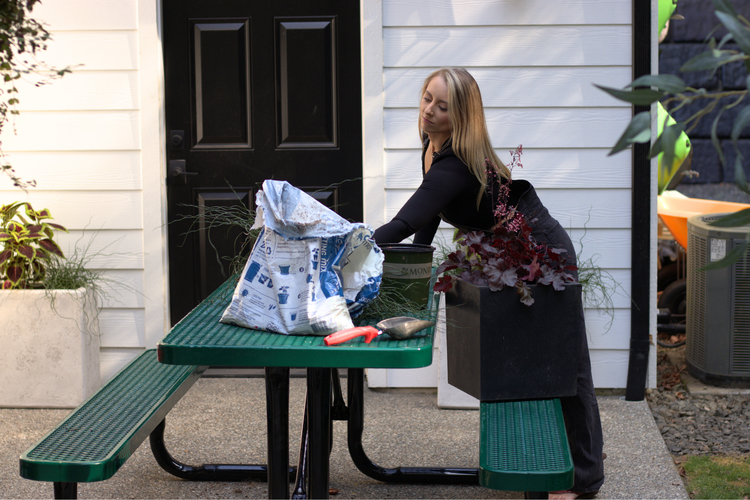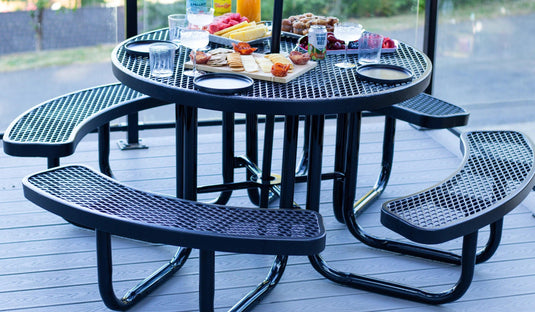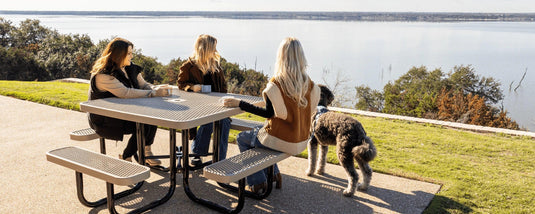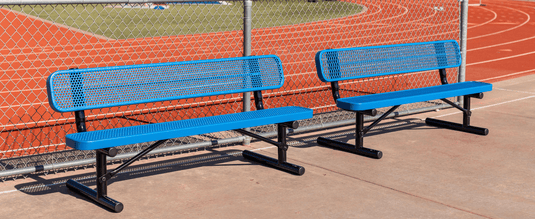If you’re outfitting a park, school, community center, or commercial patio, you’ve probably come across concrete outdoor furniture. It’s durable and heavy, no doubt—but is it really the best option?
More and more cities, businesses, and public spaces are switching to polyethylene coated steel furniture instead. Why? It offers similar strength, with fewer drawbacks.
Let’s look at how the two stack up.
1. Strength & Stability
Let’s give concrete some credit—it’s solid. Really solid. If you’re looking for something that no one will ever steal or accidentally tip over, concrete definitely checks that box.
But polyethylene-coated steel furniture also brings serious weight and durability to the table (literally). And unlike concrete, which can crack or chip over time, coated steel flexes just enough to handle temperature changes and hard use without breaking.
👉 The verdict: Both are strong, but steel offers strength without the brittleness.
2. Comfort Counts
Ever sit on a concrete bench in the middle of summer—or worse, winter? It’s either blazing hot or ice cold. Not to mention hard as a rock (because it literally is).
Polyethylene-coated steel furniture offers a much more comfortable experience. The coating doesn’t absorb heat or cold the way concrete or bare metal does. Plus, the surface is smooth, slightly forgiving, and splinter-free, making it easier on the body and better for all-day use.
👉 If comfort matters, polyethylene-coated steel is a clear winner.
3. Maintenance & Repairs
Concrete might be “set it and forget it”—until it chips, cracks, or stains. And when that happens? Repairs are complicated and expensive. Replacing a concrete bench usually means a forklift and a crew.
With polyethylene coated steel, cleanup is as easy as wiping it down with soap and water. And if something does happen, replacing a component is much simpler (and lighter).
👉 Less downtime. Less hassle. Lower cost of ownership.
4. Design Flexibility & Appearance
Let’s be honest: concrete furniture often looks… industrial. That might be fine for some spaces, but if you want furniture that adds color, style, and vibrancy, coated steel gives you a lot more to work with.
With a wide variety of shapes, styles, and colors—everything from bold playground seating to sleek modern picnic tables—polyethylene coated steel fits in almost anywhere.
👉 Want your space to feel welcoming, not just functional? Steel has the edge.
5. Installation & Shipping
Concrete furniture is extremely heavy. That can be a benefit for stability, but it also makes installation and delivery a challenge. Shipping costs are high, and installation often requires special equipment.
Polyethylene-coated steel furniture is heavy enough to stay put but light enough to move and install without a forklift. That makes it easier to reconfigure your layout, replace items, or even take it indoors during winter months if needed.
6. Environmental Conditions
Concrete doesn't always handle freeze-thaw cycles well, especially in places with harsh winters. Cracks are common over time.
Coated steel is sealed from moisture and won’t crack in extreme temperatures. It’s rust-resistant, weatherproof, and built to handle everything from coastal salt air to mountain snow.
Final Thoughts
Concrete has its place, but if you're looking for long-lasting, low-maintenance, attractive, and user-friendly furniture, polyethylene-coated steel checks all the boxes. It’s tough, comfortable, and more versatile than concrete in almost every way.
Explore our collection of commercial-grade coated steel furniture here, and see how you can upgrade your outdoor space without sacrificing strength or style.





